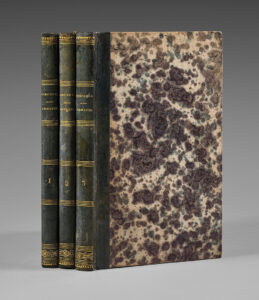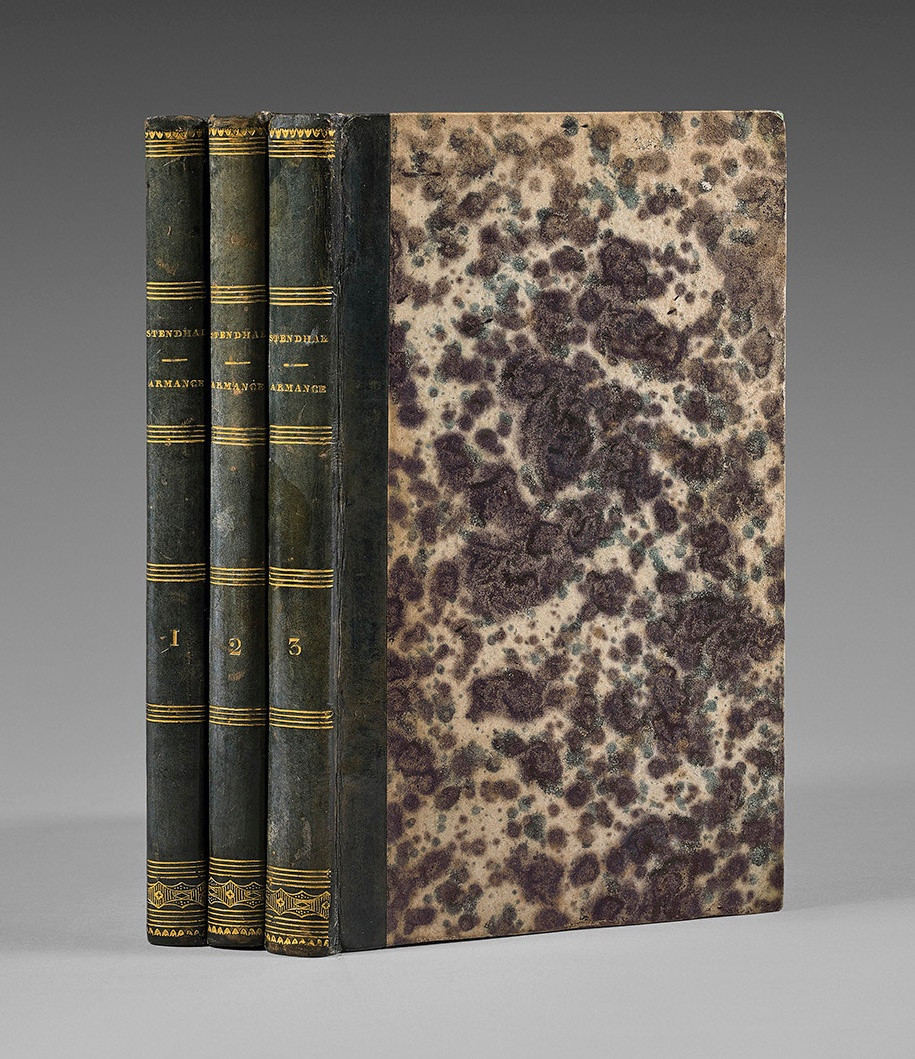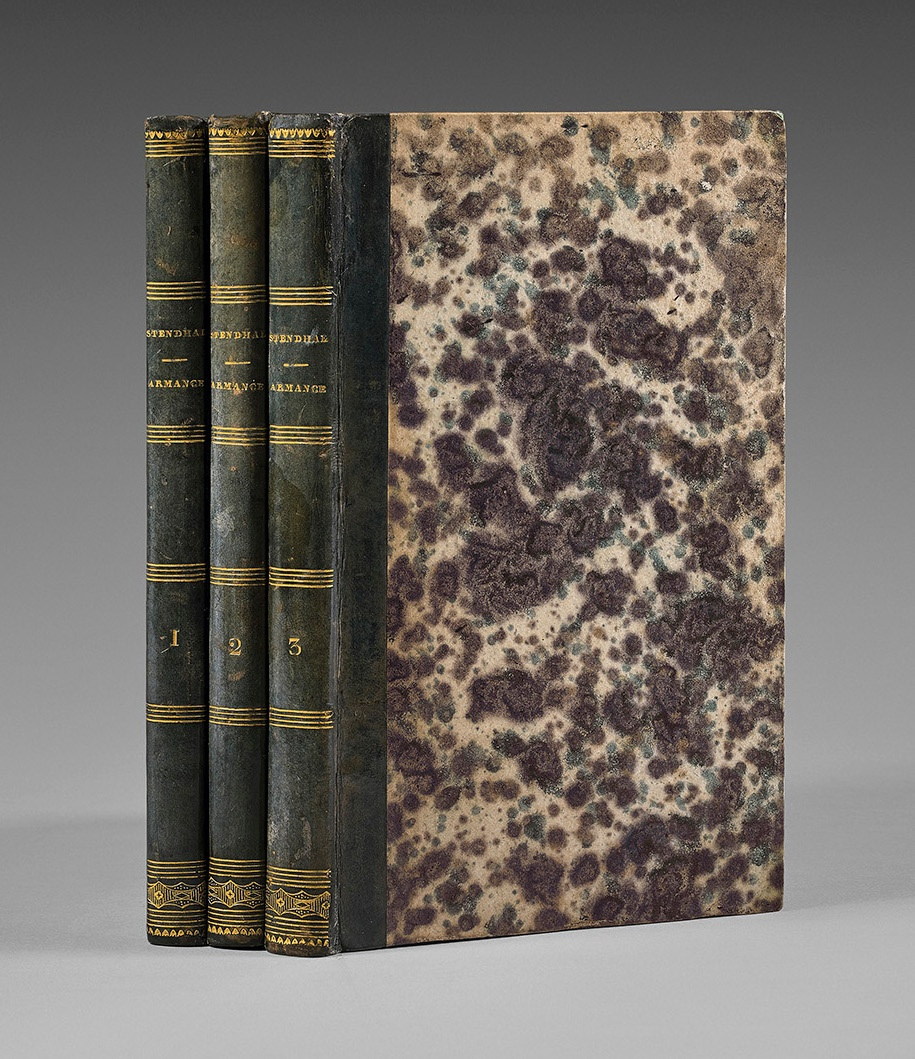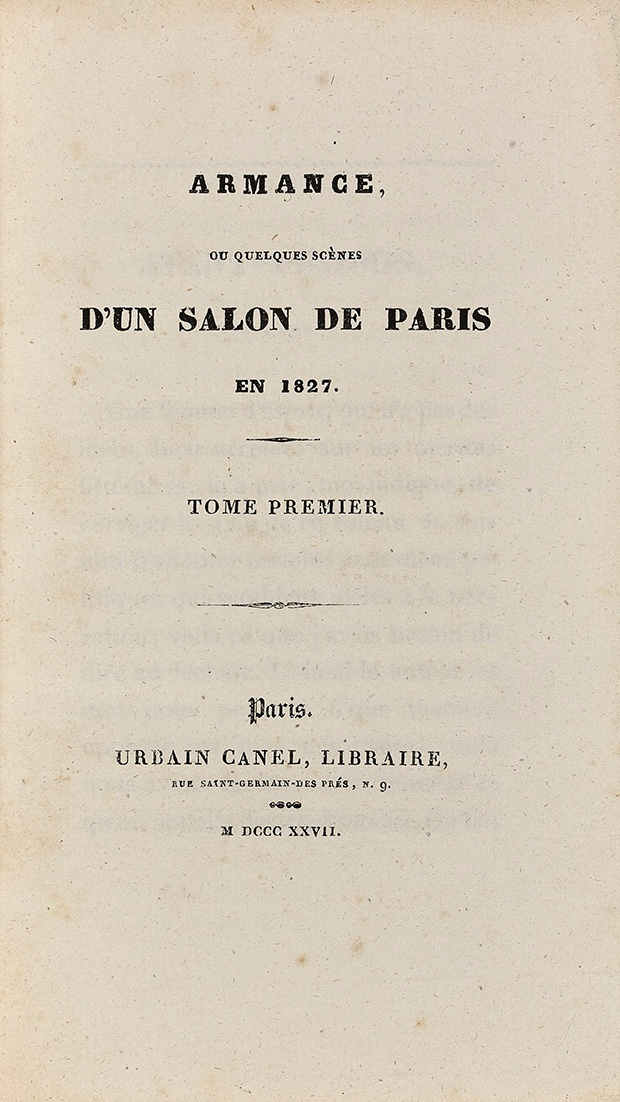Paris, Urbain Canel, 1827.
3 volumes 12mo [174 x 103 mm] of: I/ (1) half-title, (1) title, viii, 177 pp.; II/ (1) half-title, (1) title, 191 pp., pp. 169-174 browned; III/ (1) half-title, (1) title, 243 pp. Occasional slight foxing.
Blue half-calf, flat spines decorated with gilt fillets, sprinkled edges. Elegant contemporary bindings.
“Extremely rare first edition” (Claude Guerin) of the first great novel by Stendhal, printed in 1827.
“Extremely rare” (Carteret).
“Very rare, very sought-after” (Clouzot).
“The most beautiful copy seen by the great bookseller Maurice Chalvet in the course of his long career.”
“Armance” is Stendhal’s (1783-1842) first novel, published in 1827. The action happens in the high society, during the Restoration, in Paris, in the reign of Louis XVIII. Octave de Malivert, 20 years old, just got out of the “Ecole polytechnique”, got noticed by his intelligence and the distinction of his personality, but also by an exceptionally closed and lunatic temper, that pushes him sometimes to real outbursts of fury. He only shows real friendship to a cousin of his age, Armance de Zohiloff, a beautiful young, noble and poor girl with a loyal and courageous temper, that he meets at one of his aunt’s place, Mrs. de Bonnivet. A cruel misunderstanding breaks up this sweet friendship: Octave, whose family was ruined by the emigration, receives two millions for compensation by the royal government; Armance, who is secretly in love with him, thinks she notices a change in his manners after his unexpected fortune and, finding here a reason to despise the temper of her cousin, she swears to always keep her love secret, because she doesn’t want to come by as a vulgar profiteer in the eyes of Octave and those of the world. Octave, painfully struck by her coldness, and swept along in a series of high society successes, will only succeed very late to erase this mistake. He too, in reality, loves his cousin, but, mistaken by himself, and by making a solemn oath to never give in to his love life to judge himself as the most despicable of men, he is convinced that he only suffers “by friendship”.
Octave character (who, in spite of the title of the novel, is the principal protagonist) would remain a psychological enigma, if Stendhal himself, in a letter to his friend and disciple Merimee, wouldn’t have given us a key, by revealing the reasons of the dramatic scruples of his hero and his mistrust in love: Octave was always impotent.
In reality, the novel is completely based on the study of the possible dissociation between love and pleasure; but the weird persistence of the author to not unveil one of the first data of the plot introduces an arbitrary I-don’t-know-what in the game of passions, in spite of the exceptional finesse of the analysis. The work, besides its own qualities, is particularly interesting as it gives a hint of certain themes that will assert in the sequel Le Rouge et le Noir and in La Chartreuse de Parme. Don’t we find in this novel the ruthlessly picturesque and caustic analysis of the society of the Restoration, the subtle game of love first unconscious but who reveals itself invincible? Don’t we find that, at least, the first draft of these adolescent characters will be Julien Sorel and Fabrice del Dongo?
As for the exquisite beauty of this copy, it is advisable to read the notice inspired by Maurice Chalvet, the greatest French bookseller of the sixties:
« Le grand libraire Maurice Chalvet a vu ces livres en septembre 1980. Il les a trouvés très séduisants. C’était le plus bel exemplaire qu’il avait vu dans sa longue carrière de libraire. Il m’en reparlait souvent pour me féliciter de cet achat.
A son avis, et bien que non signées, ces petits livres avaient été reliés par un grand relieur. Le dernier paragraphe d’Armance est l’un des plus beaux qu’ait jamais conclu un récit.
Armance est le roman de Stendhal que préférait Gide ».
“The great bookseller Maurice Chalvet saw these volumes in September 1980. He found them very attractive. It was the most beautiful copy he had seen in the course of his long career as a bookseller. He told me about them quite often in order to congratulate me about that purchase.
According to him, and even though unsigned, these little books had been bound by a great binder. The last paragraph of Armance is one of the most beautiful that ever concluded a novel.
Armance is Gide’s favourite novel by Stendhal”.
Claude Guérin judged the present copy like that:
“Copy with the right date, in a fine contemporary binding and bound in three volumes, which is exceptional: the most often we find copies in wrappers or bound in one single volume”.
This first edition is one of the rarest of 19th Century literature.
In average a copy appears on the public market every ten years, usually in poor condition.
The last one to appear on the public market was in wrappers, dampstained, foxed, stained and dirty (described like this) ; it was sold in this condition for 73 000 €, 9 years ago (Ref. Christie’s Paris, June 25th 2009).




